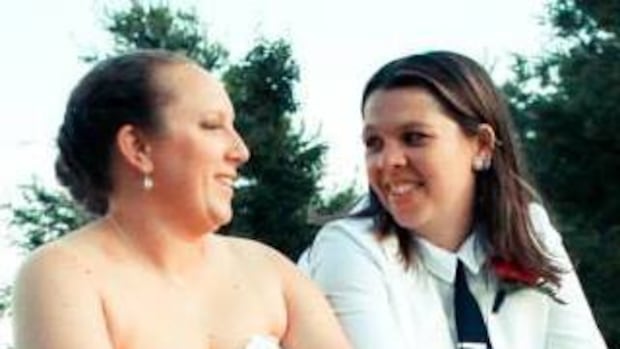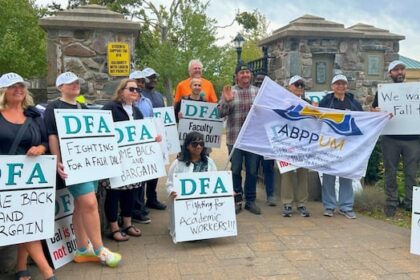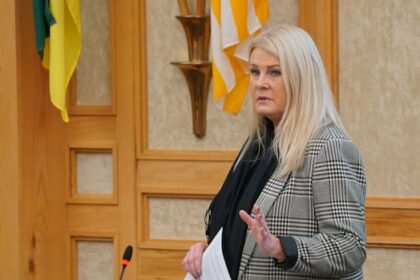WARNING: This story details allegations of child abuse.In the years leading up to the death of a 12-year-old boy in the home of his prospective adoptive parents, the Children’s Aid Society (CAS) had received at least a half dozen reports from people with concerns about possible abuse and neglect, an Ontario court has heard.But the boy and his younger brother remained in the care of Brandy Cooney and Becky Hamber for over five years, from October 2017 to December 2022, when the boy was found emaciated, soaking wet and unresponsive in their Burlington home. He died in hospital a short time later. The women are now on trial, accused of the first-degree murder of the boy, known in court as L.L., and of confinement, assault with a weapon and failing to provide the necessaries of life to his brother, J.L. The boys’ identities are protected under a publication ban. Both women have pleaded not guilty. The judge-only trial in Milton began last month and is expected to continue into December. No one from the CAS has testified yet about what steps it took to help the boys and the society is not on trial. But the case has raised questions about its involvement in the boys’ lives leading up to L.L.’s death. The Indigenous boys were wards of the CAS of Ottawa. Boys’ grandmother fought against moving the boys, court toldL.L. and J.L. were born in Ottawa about two years apart, and initially stayed in that city with their birth parents and grandparents before children’s aid sent them to live with Heather Walsh and her family, testified Walsh, their longtime foster mom. When the CAS began the adoption process with Cooney and Hamber, the boys’ grandmother fought against it in court, but lost, said Walsh.L.L. is shown on the left with his younger brother in a photo from before they lived with Hamber and Cooney. CBC has blurred the faces of the boys, whose identities are protected under a publication ban. (Ontario Superior Court in Milton)The boys were moved to Burlington in 2017 and the Halton CAS took over daily supervision, court heard. Hamber and Cooney never completed the adoption process.Erin Nolan, a therapist at a children’s mental health centre in Oakville, told the court the CAS had concerns about how the women responded to “allegations” made by the children and the two didn’t work well with service providers. Nolan was part of a team the women were hoping could provide therapy to L.L. and J.L. The team communicated with Cooney and Hamber in 2021 and early 2022. “Ottawa CAS was still assessing [Cooney’s and Hamber’s] capacity to meet the boys’ needs,” Nolan said. The women also had a tendency to “pathologize” the children, treating them as psychologically unhealthy when they may not have been, Nolan said. The two women ultimately decided not to go with Nolan’s services as they took issue that she was required to report any concerning allegations the boys made to children’s aid. The women said L.L. lied, and the CAS would be “banging down their doors at night and it would be disruptive to their family,” Nolan testified. Therapist, police reported to CASThe Crown has argued Cooney and Hamber struggled to care for the boys, and also hated, neglected and abused them. However, they’d come to rely on the financial subsidies they received through government adoption programs, Crown attorney Kelli Frew said in her opening statement.In cross-examinations, the defence has focused on the boys’ behaviour and has argued that L.L. was exceptionally difficult to manage. The women’s lawyers have said they were doing the best they could with little help or support from children’s aid.Cooney, left, and Hamber, right, as sketched in the Milton courtroom after they pleaded not guilty to first-degree murder. (Pam Davies/CBC)Attachment therapist Beth Sibley worked with the boys during the transition. She testified she had concerns about the women’s parenting abilities almost immediately. During one of their first sessions in Burlington, L.L., then 6, told Sibley he’d “punched” Hamber because he was angry about no screen time and, as a result, had been forced to stay in his room all day and not go to school, Sibley said. She said that punishment seemed “excessive” and she reported it to children’s aid. “We know if a child is isolated that it causes them to stress, and distress creates more behaviours,” Sibley told the court. Halton police also reported an incident at Cooney’s and Hamber’s home to the CAS, according to a police report filed as a court exhibit.In the summer of 2019, a neighbour called police after hearing one of the boys crying and screaming “for well over five minutes,” the report said.When the officer arrived, Hamber and Cooney said L.L. had been having a tantrum in the backyard and had since calmed down. While the officer noted “there was no immediate risk at the time,” and the boys were “sufficiently cared for and had the basic necessities,” they were “obviously having a difficult time adjusting to their new home.” The officer found J.L.’s bedroom was “completely covered in tarps” and the brothers didn’t have beds, but rather small cots resembling those used in daycares. The women said it was because the children had trouble controlling their bladders. At the bottom of the report, the officer noted it would be sent to the Halton CAS for followup. Teacher called CAS 4 timesJ.L.’s Grade 2 teacher, Sara Biasetti, testified she called children’s aid four times over the 2019-2020 school year. She described J.L. as very smart and helpful. But as the months progressed, she said, she became “terrified” for him as he tried to harm himself and told her details about his home life. The first time Biasetti called the CAS was after J.L. wrapped a piece of twine around his neck and his face turned purple, Biasetti told the court. “I said how concerned I was that he keeps saying he wants to die.”The caseworker for Halton region told her it’s “too political” to intervene and CAS would need more evidence.J.L.’s room in a photo taken after L.L. died in 2022 and filed as a court exhibit. The boys didn’t have blankets and J.L. slept in a mesh tent, the court heard. (Ontario Superior Court in Milton)Biasetti said she called the CAS again when J.L. told her his brother was “locked” in the basement and how Cooney and Hamber used zip ties to keep him in a onesie so he’d stop “having accidents.” “I called just to get these kids some help,” she said.The women controlled what the boys ate, even at school, Biasetti said. Staff were instructed to supervise them at lunch to make sure they finished all of their food and not give them any extra snacks.The women told the school it was because they would otherwise steal and hoard food and lie about being hungry, said Biasetti. She said she never witnessed those behaviours. One day, J.L. came to school with “disgusting” green mouldy lunch meat, which he was trying to eat but was “gagging,” and didn’t finish it all, said Biasetti. She said J.L. later told her that after school, he was locked in his room and given five slices of the same mouldy meat for dinner. She said she reported that to children’s aid as well. ‘I have so much guilt,’ teacher saysL.L.’s Grade 4 teacher, Sara Ferraro, had similar concerns as Biasetti and the two worked together to document the case for the CAS, Ferraro said in the witness box. During her testimony, she broke down in tears, sobbing.“I have so much guilt,” she said. “It breaks my heart every single day” about what happened to L.L.Cooney and Hamber said L.L. wasn’t allowed to take books out of the library, play with other kids at recess, use the classroom computers, go on field trips, or take part in choir or cross country, Biasetti said. J.L., left, and L.L. are shown in an undated photo filed as a court exhibit. Their Burlington teachers described them as clever, curious and eager students. (Ontario Superior Court in Milton)“The language they [the two women] used to describe their own child was alarming,” she said. “They would use terms like he was ‘vile, he was always scamming, manipulative and sneaky.’” But, Ferraro said, L.L. was an eager student and she didn’t observe any behavioural issues outside of what was normal for his age.Then, at the beginning of 2020, J.L. and L.L. only attended school for half the day, sporadically, and fell behind academically. In February, the school’s principal, superintendent, Biasetti, Ferraro, CAS workers, Hamber and Cooney met. The teachers said they made all of their concerns about Hamber and Cooney clear to the CAS in the meeting, and advocated for the boys to return to school full time. “They were great and we wanted them there,” Biasetti said. “I wanted [J.L.] to get the full experience of being a kid.” Before that could happen, however, the COVID-19 pandemic hit and classes went online. Neither boy participated in the virtual lessons. At one point, in April, J.L. sent Ferraro a video of himself. She was alarmed to see him wearing a onesie, the zipper secured with a zip tie.Ferraro said she called the CAS a fourth time and her principal reported the video too. They never found out if children’s aid intervened in any way. But the boys never attended school again before L.L. died in 2022, the court heard.Women smiling, laughing after L.L.’s death, says doctorDr. Nora Labib testified she was working in the emergency department the night L.L. was found without vital signs at home and then he was rushed to hospital. He was the size of a six-year-old, with “almost no muscle on his body, just skin and bone,” she recalled.A wetsuit was found in L.L.’s room after he was rushed to hospital the night he died. The Crown says he and his brother were forced to wear them. (Ontario Superior Court in Milton)During resuscitation efforts, and after it became clear he couldn’t be saved, Labib said she was alarmed not only by L.L.’s size and condition, but also by how Cooney and Hamber responded. “When I went to break the news, I think I was more distraught and more upset than they were. They took it well,” Labib said. Later, she said, she “observed them smiling, laughing, acting like it was a casual thing, which [left] me very unsettled and very surprised.” She called children’s aid that night, also concerned about J.L.’s well-being as he was still in their care. “I asked them to remove the brother from the home while they investigate and they said there’s not enough evidence,” Labib said. The court has heard J.L. was sent to a new foster home a few days later. If you’re affected by this report, you can look for mental health support through resources in your province or territory .
Wednesday, 17 Dec 2025
Canada – The Illusion
Search
Have an existing account?
Sign In
© 2022 Foxiz News Network. Ruby Design Company. All Rights Reserved.
You May also Like
- More News:
- history
- Standing Bear Network
- John Gonzalez
- ᐊᔭᐦᑊ ayahp — It happened
- Creation
- Beneath the Water
- Olympic gold medal
- Jim Thorpe
- type O blood
- the bringer of life
- Raven
- Wás’agi
- NoiseCat
- 'Sugarcane'
- The rivers still sing
- ᑲᓂᐸᐏᐟ ᒪᐢᑿ
- ᐅᑳᐤ okâw — We remember
- ᐊᓂᓈᐯᐃᐧᐣ aninâpêwin — Truth
- This is what it means to be human.
- Nokoma











